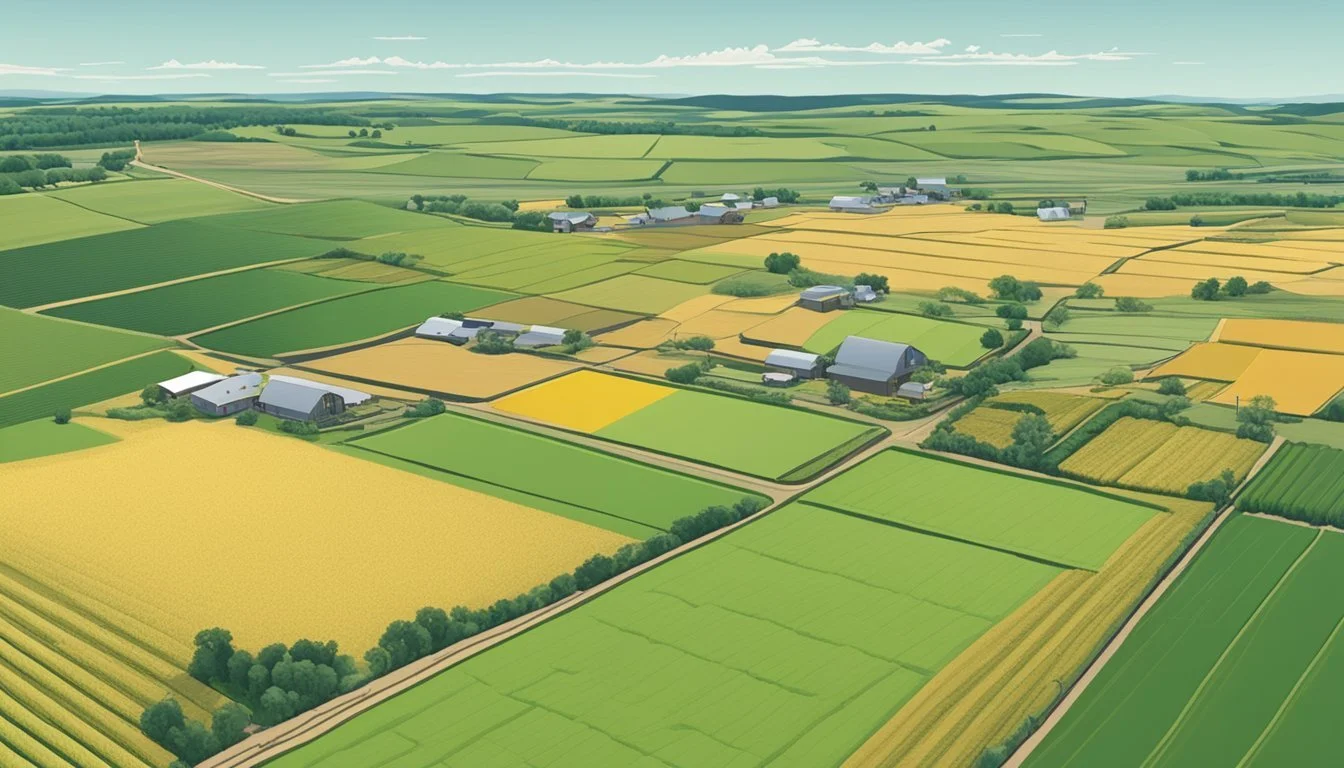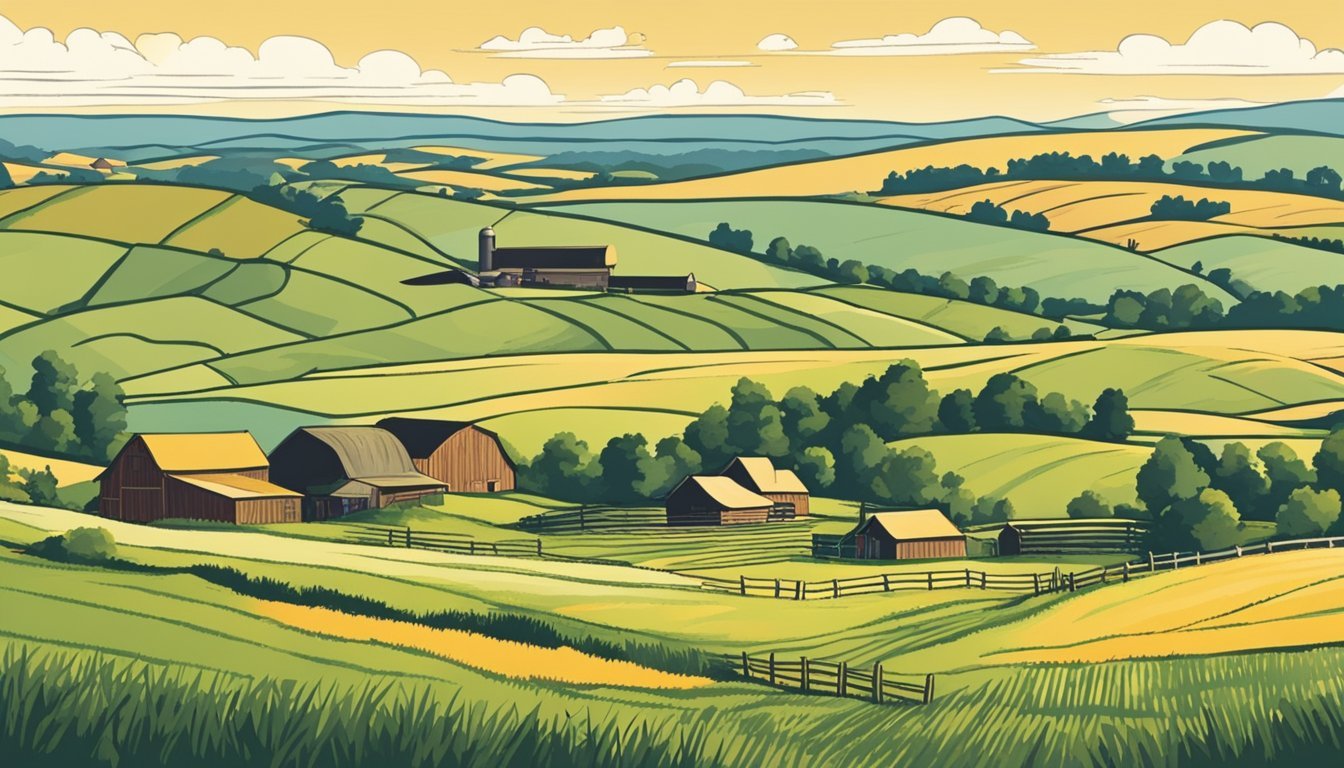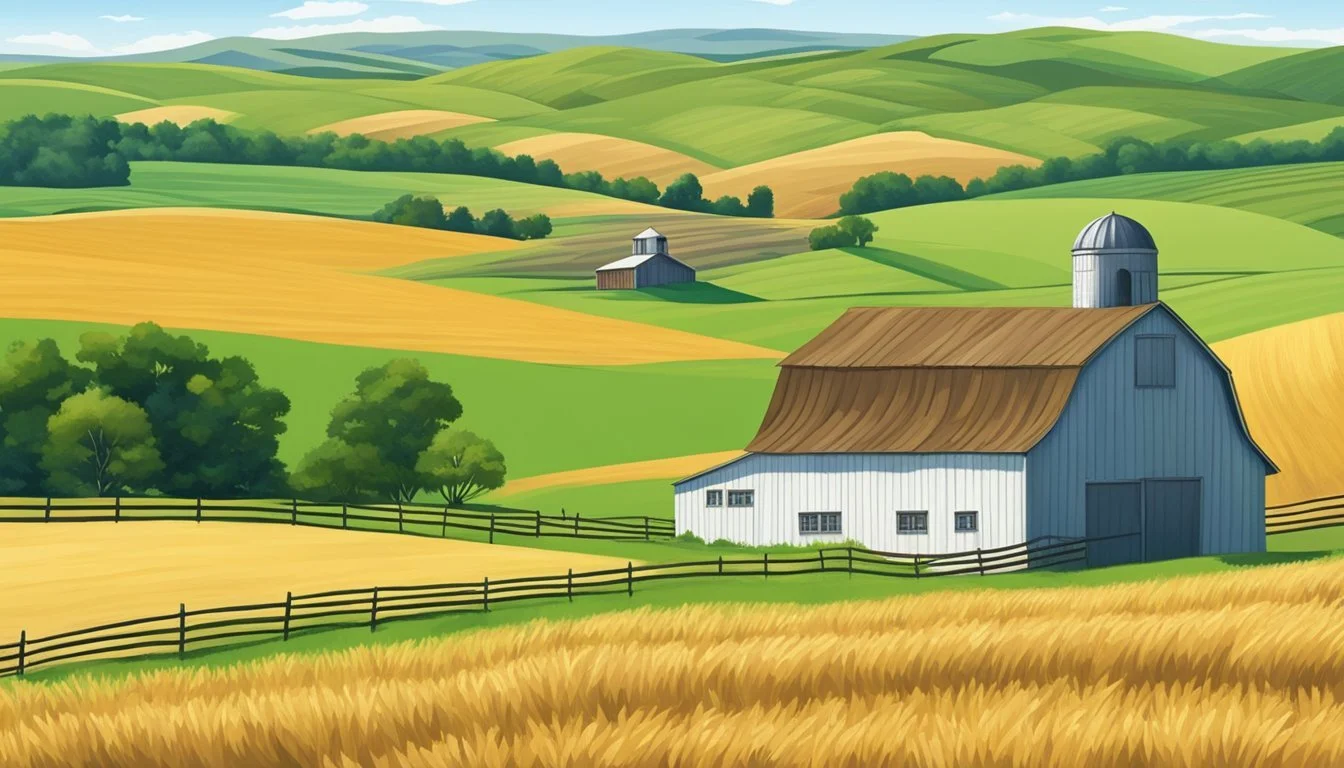South Dakota Farm Land for Lease
Opportunities and Considerations
This Article is Part of Our Guide on Navigating Agricultural Leases Across the US
South Dakota offers a variety of farm land available for lease, presenting opportunities for agricultural businesses and individual farmers alike. The state's rich soil and favorable climate conditions make it a prime location for various types of farming, from crops to livestock. As such, South Dakota farm land attracts interest from those looking to engage in agriculture without the upfront investment of purchasing property.
Leasing land in South Dakota provides a flexible option for expanding operations, trying out new agricultural practices, or starting a farm. The range of properties available for lease includes everything from large-scale plots to smaller acreages suitable for boutique farming or specialty crops. This flexibility in land size and usage type caters to a diverse set of agricultural needs and business models.
As the agricultural sector adapts to market demands and technological advances, leasing farm land in South Dakota emerges as a strategic choice for farmers who value adaptability and reduced financial risk. Producers seeking to lease land in the state will find a variety of options, whether their focus is on crop production, animal husbandry, or a combination of agricultural undertakings.
Understanding Land Leasing in South Dakota
In South Dakota, the leasing of farm land is a critical component of the agricultural industry, encompassing various lease types and governed by specific state laws.
Basics of Farm Land Leasing
Farm land leasing involves a landowner granting a tenant temporary possession and use of real property for agricultural purposes. In return, the tenant typically pays the landowner rent, which may be a fixed cash payment, a flexible cash payment based on production or prices, or a share of the crop produced. In South Dakota, these arrangements provide a pathway for landowners to earn income from their land without directly engaging in farming activities, while giving tenants an opportunity to farm without needing to purchase property outright.
Types of Leases:
Fixed cash lease: The tenant pays a set amount to the landowner annually.
Flexible cash lease: The payment depends on crop yields, prices, or a combination of both.
Crop share lease: Landowner receives a percentage of the crop or revenue in lieu of cash rent.
South Dakota Leasing Laws
The legal framework surrounding farm land leasing in South Dakota stipulates that leases can be verbal or written, although written leases provide more clarity and are less prone to disputes. Landowners and tenants must be aware of the legal requirements and protections in place:
Oral Leases: These typically renew automatically, but parties must provide notice by September 1 if changes are to be made for the following year.
Written Leases: More formal, outlining terms such as rent amount, lease duration, and tenant responsibilities.
It's essential for both parties to understand their rights and responsibilities under South Dakota law. Lessees should return the property in the agreed-upon condition at the end of the lease term, and both parties must adhere to the lease's terms, the implications of which are enforced under state real estate and property laws.
Types of Farm Land Available for Lease
In South Dakota, prospective lessees can find diverse types of farm land tailored specifically for agriculture or ranching. Each type offers distinct features based on its intended use, size, and the nature of the lease agreement.
Crops and Agriculture
Farm lands dedicated to crops and agriculture in South Dakota often range in size and soil fertility, catering to various types of farming operations. Lessees can lease land for:
Row Crops: These lands are suitable for soybeans, corn, and other row crops, offering large, flat acreage that allows for efficient mechanized farming.
Specialty Ag: Smaller parcels might specialize in niche markets like organic farming or vineyards, requiring specific soil types.
The types of lease agreements for these agricultural lands typically fall into fixed cash payment, flexible cash payment, or crop share arrangements.
Ranch Land Configuration
Ranch land in South Dakota is characterized by its larger acreage, often accommodating livestock such as cattle and sheep. They come with:
Ample grazing areas
Necessary water sources
Fencing and infrastructure for animal husbandry
Ranch lands are typically leased through a fixed cash payment or a livestock share agreement, where the rent may be paid in part with the livestock produced on the land.
The Leasing Process
When beginning the process of leasing farm land in South Dakota, it is important to understand the steps involved to make informed decisions. This section will guide through finding available land, negotiating terms, and utilizing available resources to secure a lease that fits one's agricultural needs.
How to Find Land to Lease
Prospective tenants should begin by searching specialized agricultural marketplaces like LandCashin, which offer listings specific to South Dakota. Additionally, individuals can:
Utilize online land search platforms that list agricultural properties for lease.
Contact local agricultural extension offices for possible leads.
Network within farming communities or through agricultural associations.
By setting clear criteria for the desired land, tenants can efficiently shortlist potential properties that match their requirements.
Negotiating Lease Terms
Once a suitable piece of land is identified, leasing terms become the focus. South Dakota offers several types of leasing arrangements:
Fixed Cash Payment: A predetermined amount paid annually or per season.
Flexible Cash Payment: An amount that varies based on crop yields or market prices.
Share of the Crop: Payment made with a portion of the crop produced.
It's essential to draft a contract that stipulates:
Lease Duration: How long the agreement will last.
Rent Amount: The cost of leasing and payment schedule.
Land Use: Specific types of crops or farming practices permitted.
Maintenance and Improvements: How land maintenance responsibilities are divided.
Tenants should also be aware of legal timelines, such as oral lease renewals which, according to the SDSU Extension, must take place by September 1st.
Deal Alert Program
For tenants looking to stay informed about new listings, the deal alert program can be an invaluable resource. Services such as LandSearch may offer:
Notifications: Automated alerts for new properties that fit set criteria.
Marketplace Insights: Updates on price changes and market trends.
Registering for a deal alert program ensures that one does not miss out on prospective leasing opportunities as they become available on the marketplace.
Financial Considerations
When considering South Dakota farmland for lease, one must understand the complexities of lease rates, the potential financial benefits, and the tax and insurance implications associated with such real estate agreements.
Determining Lease Rates
In South Dakota, determining appropriate lease rates involves analyzing current market trends and land value surveys, such as the South Dakota State University (SDSU) Extension Farm Real Estate Market Survey. Lease rates can fluctuate, influenced by factors like land quality and regional agricultural demands. On average, rates have seen an increase over the past two decades, emphasizing the need for up-to-date regional data. Landowners and farmers should consider:
Current Rental Rates: Researching the latest data on cash rent per acre to align with the market.
Capitalization Rate: Utilizing the average implied capitalization rate to assess rental price fairness.
Financial Benefits of Leasing
Leasing farmland in South Dakota offers financial flexibility for both landowners and tenants. Benefits for the landowner include:
Steady Income Stream: Securing an ongoing return on investment through fixed rent payments.
Reduced Operational Costs: Minimizing the expenses associated with active farm management.
Tenants may benefit from:
Lower Initial Investment: Accessing farmland without the high upfront cost of purchasing property.
Operational Flexibility: Adjusting farming operations with relatively short-term lease agreements rather than long-term property commitments.
Taxes and Insurance Implications
Leasing farmland also has tax and insurance considerations that should not be overlooked. Landowners must navigate:
Income Tax: Reporting rental income, which may be subject to tax.
Landowner Insurance: Maintaining appropriate coverage for their real estate assets against potential liabilities.
Tenants are responsible for:
Lease Expense Deductions: Exploring the possibility of deducting lease payments under certain tax regulations.
Tenant Insurance: Acquiring insurance to protect against crop loss and other operational risks.
Properly addressing these financial obligations is crucial to ensure the leasing arrangement is beneficial and sustainable for all parties involved.
Regulations and Compliance
When leasing farmland in South Dakota, it is essential to understand and adhere to the various regulations at both the county and state/federal levels to ensure legal compliance.
County-Level Regulations
Each county may have specific ordinances that affect the leasing and use of agricultural land. Lessee and lessor should verify these at the county's land records office or local government website. For example, fencing regulations might require adjoining landowners to equally share the cost of maintaining boundary fences, unless an alternative agreement is in place.
State and Federal Compliance
South Dakota state law outlines clear rules regarding farmland leasing. Tenant and landlord must be aware that without a written lease, notice for termination must be given on or before September 1; otherwise, the lease is considered automatically renewed. If notice is timely, the tenancy ends by law on March 1. Moreover, nonresident aliens who acquire agricultural lands in South Dakota through devise or descent must sell these lands within three years. At the federal level, lessees and lessors must ensure that their agreements comply with USDA regulations and any other applicable federal laws.
Resources and Support
When seeking farm land for lease in South Dakota, resources and support are key components for a successful transaction. Landowners and potential lessees can benefit from professional real estate assistance and specialized marketplaces tailored to agricultural property.
Professional Real Estate Assistance
Professional real estate services provide invaluable guidance through the complexities of leasing agricultural land. These services help in understanding local market conditions, legal regulations, and proper valuation of the property. They ensure that both landowners and lessees enter a fair and legally binding agreement.
Services include:
Property valuation and market analysis
Lease agreement formulation
Negotiation support
Legal compliance and documentation
LandCashin Marketplace
The LandCashin marketplace is an online platform specifically designed for the buying, selling, and leasing of agricultural land. It creates a centralized location where landowners in South Dakota can list their properties, and potential lessees can browse available listings.
Features of the LandCashin Marketplace:
User-Friendly Interface: Simplifies the process of finding and listing agricultural property.
Focused Listings: Concentrates solely on the sector of agricultural land, making it more effective than general real estate platforms.
SD Presence: Tailors its services to meet the unique demands of the South Dakota agricultural market.
By utilizing these resources, stakeholders in the South Dakota farm leasing market can engage effectively and ensure that their agricultural land serves their strategic goals efficiently.
Conclusion
The landscape of farm land leasing in South Dakota is well-established, with a significant portion of agricultural land and farming operations involving leasing arrangements. The state's real estate market surveys, such as those conducted by SDSU Extension, provide extensive data on land values and rental rates, affording transparency and consistency to the leasing process.
Agricultural Land Values and Rental Rates: In regions across South Dakota, rental rates vary considerably, reflective of varying land quality and use. Recent data indicate trends showing specific rates for nonirrigated cropland across different regions.
Trend Highlights:
Southeast: Higher rental rates on average.
Central and Western Regions: Comparatively lower rates.
Legal Considerations: It is important for both parties entering a lease agreement to be aware of legal stipulations. In South Dakota, oral leases renew automatically, creating a need for timely communication should any adjustments or terminations be required.
Market Survey Utilization:
Landlords and tenants benefit from the use of market surveys.
Surveys offer guidance and benchmarking for fair and competitive pricing.
In summary, South Dakota presents a robust farm land leasing market, supported by thorough research and a legal framework that seeks to balance the interests of landlords and tenants. Potential lessees and lessors are encouraged to engage with available resources to ensure a mutually beneficial arrangement.








